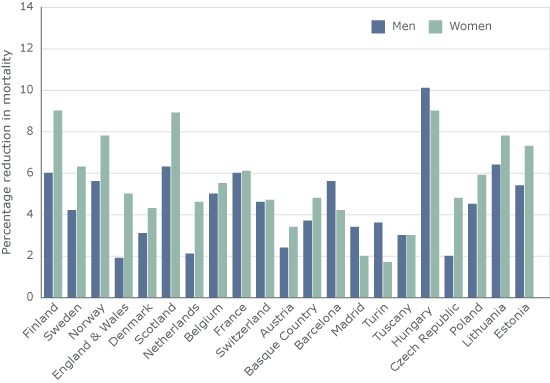Across Europe, there have been consistent educational improvements for both women and men over time. Higher levels of education have been traditionally associated with lower mortality rates. Ivana Kulhánová, et al. estimate how further improvements in educational attainment influence future mortality reductions.
In their study of 21 European countries, the authors build two different scenarios. In the first, where the educational attainment of older generations is replaced by that of the younger generations (cohort replacement scenario), there is a reduction of mortality ranging from 1.9% to 10.1% for men and from 1.7% to 9.0% for women. In the second scenario, in which all obtained tertiary education (upward levelling scenario), the gains are considerably higher than in the first scenario: The mortality reduction ranged from 22.0% to 57.0% for men and from 9.6% to 50.0% for women. Such evidence shows that further investments in education can have substantial positive effects on population health.
No clear geographical pattern
Kulhánová and her colleagues found that the replacement of educational levels between older and younger generations generates a proportional reduction of mortality that does not follow a clear geographical pattern across Europe (Figure 1). Among men, the largest reduction in mortality is observed in Hungary, followed by Lithuania and Scotland, while the greatest reductions for women are in Finland and Hungary, followed by Scotland, Lithuania, and Norway. The smallest reductions are found in Denmark and the Netherlands for men, and Madrid (Spain) and Turin (Italy) for women. Thus, in this scenario women benefit more than men in terms of mortality reduction because currently, overall the level of education is either similar or higher among women.
Instead, a regional pattern emerges amongst European countries in the second scenario, in which all people obtained tertiary education and, as a consequence, have lower mortality levels (Figure 2). Among both men and women, mortality decreases are the highest in Central/East Europe, followed by Northern, Western, and Southern Europe, respectively. The authors explain the greatest potential gain in mortality in Central and Eastern European countries by arguing that their communist history led to a distribution in which a large proportion of people have primary and secondary educations but very few have tertiary education.

Figure 1. Percentage reduction in all-cause mortality in the first scenario, 30–79 years

Figure 2. Percentage reduction in all-cause mortality in the second scenario, 30–79 years
This Population Digest has been published with financial support from the Progress Programme of the European Union in the framework of the project “Supporting a Partnership for Enhancing Europe’s Capacity to Tackle Demographic and Societal Change”.